Jean Guerrero?s new book explores how Stephen Miller became one of the most powerful, anti-immigrant White House advisers in history
 Photo illustration, source: Alex Wong/Getty Images
Photo illustration, source: Alex Wong/Getty Images
White House senior adviser Stephen Miller has been the driving force behind the Trump administration?s most racist policies over the past few years, breathing life to an agenda long-imagined by white nationalists. But how did the descendant of Jewish refugees find himself crafting policies that would have certainly banned his family from coming into the United States in the first place? Investigative journalist Jean Guerrero tries to answer the question of Miller?s embrace of white supremacy in her new biography Hatemonger: Stephen Miller, Donald Trump, and the White Nationalist Agenda, out on August 11.
Guerrero carefully charts the 34-year-old?s radicalization, from being mentored by right-wing activists in his teenage years to crossing paths with white nationalist Richard Spencer at Duke University, before landing as a public relations flack for some of Capitol Hill?s most conservative members. It?s in Donald Trump, however, that Miller sees a kindred spirit and a potential savior against the brown hordes he fears are invading America.
We spoke with Guerrero about how Miller became a case study in indoctrination, how he laundered the language of white nationalism to make Trump more appealing, and the impact his anti-immigrant policies will have on America for years to come.
GEN: Why did you want to write a book about Stephen Miller?
Jean Guerrero: It started when I was covering the family separation crisis at the border. I?d been interviewing all of these parents who had had their children taken away from them by U.S. officials. I was hearing the White House and then-DHS Secretary Kirstjen Nielsen talking about how this policy was really about national security, and how they were only separating people who had broken the law. I was on the ground at the busiest border crossing in the United States; I knew that that wasn?t the case. It raised the question: If this isn?t about law and order, then what is it about? That?s what led me to Stephen Miller, the man behind most of the administration?s immigration policies. He had grown up in Southern California at the same time as I did in the ?90s. I became fascinated with trying to understand his story: how a Jewish American descendant of refugees becomes the person crafting Trump?s harsh rhetoric and policies, targeting people fleeing violence, people like his own great-grandparents.
How did his formative years lead him to his current beliefs and put him on the path to the White House?
He grew up in California at a time of extreme anti-immigrant hostility. Then-Republican Gov. Pete Wilson was blaming all of the state?s fiscal problems on ?the invasion at the border.? There were attacks on affirmative action, bilingual education, and social services for children of the undocumented. It was scapegoating migrants for everything that was going wrong in California. Stephen Miller was going through a period of family turmoil and looking for someone to blame. His dad is a real estate investor who was very similar to Trump ? tangled up in numerous legal disputes and bankruptcies related to his real estate companies. Court documents described him as a master of evasion and manipulation. This whole thing started out with Stephen Miller trying to get his father?s attention by acting out. He started to express very combative and extreme conservative views when his father lost a lot of money related to his legal disputes. The family had to move to a less affluent part of town and he had to go to this public high school that was very diverse, instead of going to a private school like his younger brother later attended.
He started telling his Mexican classmates to speak English, telling them to go back to their countries, going to school board meetings to argue against measures to improve racial equity. Then, he meets these radical conservatives who begin to indoctrinate him. He is a case study in radicalization.
One of the most affecting parts of the book is when you speak with Miller?s former friend Jason Islas. The summer before high school Miller called him and said they couldn?t associate anymore because Jason is Latino. He tells you: ?I really think people ought not to be judged for the rest of their lives by who they were in middle school. However, Stephen Miller?s personality calcified into something pretty dark.? It?s so telling about the long-lasting impact of his radicalization as a teen.
I approached this project with a very open mind, thinking maybe Stephen Miller has been misunderstood. When I was learning about his childhood, I almost related to the young him because I remember internalizing California?s intense white supremacy. My mother used to tell me, ?You are American. You?re not Mexican. You?re not Puerto Rican.? Looking back, I realize that?s because she faced a lot of discrimination as a doctor because of her Puerto Rican accent and being perceived as an other. She wanted me to feel a sense of belonging and to be seen as belonging. In a way, I understand Stephen Miller as a young man wanting to be perceived as an American with all the privileges that?s supposed to guarantee. The problem is, Miller sounds the same today as he did at 16.
One of the key figures he meets as a teen is conservative activist David Horowitz. He believes that everything that we hold dear in America is the result of white men, and that liberals pose an existential threat to America because of their allyship with Muslims and other people who always happen to be people of color. Miller ends up becoming obsessed with this idea that by attacking rights for immigrants, by attacking liberals and progressives, he is in some way saving the country. Horowitz says that he?s not a white nationalist and he?s not a racist, he?s colorblind. But look at how steeped in race and skin color his rhetoric is. He taught Stephen Miller how to launder white nationalist ideas through the language of heritage, of economics, of national security. That?s ultimately what made Stephen Miller so effective for Trump.
Miller was close to white nationalist Richard Spencer at Duke University, but has since denounced him. Why do you think that he is not more publicly associating with ideologues like that, even when echoing their beliefs?
He understands that he needs to launder the language in order to make it palatable. There?s a lot of people who support Trump, his harshest policies and rhetoric, but they don?t consider themselves to be racist or white nationalists. If Stephen Miller or Trump were to start speaking very explicitly in the language of race and skin color it would turn off not his base, but a lot of moderate Republicans. That?s why they?ve been so careful.
The thing is, if you actually familiarize yourself with the language of white supremacy and connect the dots between what Stephen Miller is saying, doing, and his motivating influences, you begin to realize that he?s not tiptoeing around it that much.
You write that Miller viewed America as a damsel in distress that needed to be saved from being penetrated. It hints at a very rigid notion of masculinity, similar to his obsession with the Mafia and gangster movies.
When you look at American history, a lot of the violence that has been committed against the Black body has been rooted in the fantasy of Black men raping white women and trying to protect white women from Black rape. This whole notion of needing to protect America from being penetrated by the brown hordes is something you see again and again in the literature that Stephen Miller was reading over the course of his life.
To me, one of the most fascinating things is how those rigid notions of masculinity in Stephen Miller are very similar to the rigid notions of masculinity in Donald Trump. It?s part of why they get each other and why Stephen Miller has been able to stick around so long. He always pushes Trump in the harshest, most aggressive direction, whereas other advisors often encourage Trump to take a more moderate path. That ends up with his base ridiculing him as weak, which Trump doesn?t like because it offends his self-perception as a masculine man.
Can you talk about Trump and Miller? They?re very similar men ? they sort of mirror each other ? but also have a surrogate father-son relationship.
Reading Mary Trump?s book was pretty illuminating. I already knew about some of the parallels between them, but learning about how Trump?s brother and his niece Mary got pushed out of the family inheritance, that?s something that happened in Stephen Miller?s family. His paternal uncle got permanently separated from the family with a no-contact order and was deprived of a majority of the family inheritance. The other thing is, Miller gets Trump emotionally, psychologically, and spiritually. They share similar values about the importance of being a killer in society. Numerous White House officials that I spoke with said that they?re always afraid to challenge Miller because he is always invoking Trump?s name, his desires and demands. To challenge Miller is essentially to challenge Trump. That?s one of the ways that he?s been able to stay there so long when many people have resigned or been forced out. Steve Bannon was very obsessed with talking about his important role in shaping Trumpism, while Stephen Miller is always very careful to cast himself as a mere devoted vehicle for Trump?s agenda.
Miller also helped shape Trumpism during the 2016 presidential election. Could you tell me how?
Most people don?t realize how critical Stephen Miller was for Trump?s win in 2016. Bannon got mythologized because he speaks to the media and talks himself up. But Miller is the person who was there from the very beginning. He was giving the Trump campaign free labor months before he was officially hired, helping shape immigration policy and sending them talking points. He was critical in obtaining the Border Patrol and ICE unions? endorsements for Trump. At the time there were a lot of immigration hardliners who rolled their eyes at Trump because his border wall was his only real immigration proposal. It was only when Stephen Miller came to the campaign and started pulling policies directly from think tanks like the Federation for American Immigration Reform ? which was created by John Tanton, a eugenicist who believes in population control for non-white people and believes in race-based pseudoscience about the genetic superiority of whites ? that made those people realize, ?Oh okay, Trump is actually serious about trying to limit immigration.? That?s what Miller ended up doing in the White House, focusing on limiting family migration, refugees, and asylum seekers.
I don?t think Stephen Miller is some mastermind. He?s just really good at regurgitating the talking points of other people. He?s disciplined and hardworking in a way that few other people in the White House are. That?s how he ends up having his outsized influence.
I want to talk about the way Miller has reshaped the immigration system. What do you think is going to be the long lasting impact of his policies?
He?s destroyed the United States? global reputation as a beacon of hope, providing refuge for people across the world who need it. He?s come down so heavily on refugee admissions, we?re hitting new historic lows every year. From the moment that Stephen Miller arrived in the White House he was focused on narrowing the focus of the Department of Homeland Security from its very broad mandate of protecting Americans from a range of threats ? from terrorism to pandemics ? into something that was very focused on civil immigration. Targeting families, targeting children, targeting people who, for the most part, had not broken any laws with the exception being the zero-tolerance policy, which targeted people who had committed the misdemeanor of illegal entry.
That makes America much more vulnerable to real threats like the pandemic. Instead of being focused on the distribution of masks and testing, the administration has been really focused on creating distractions again by blaming immigrants for the job situation ? suspending green cards, shutting down all asylum in the U.S.-Mexico border, coming down on international students. They?re scapegoating immigrants again for everything that?s going on in the pandemic to distract from Trump?s disastrous response to it.
Miller is also trying to find ways to keep people out through legal routes. They?re re engineering the ethnic flows into the U.S. to try to make it a more white country. To me, that goes back to the California of Stephen Miller?s youth. White people became a minority in the ?90s in California. I feel that created a lot of white fear, white resentment, and this idea that California was going to turn into this third world. Now you see that happening on a national scale. Stephen Miller thinks, because he was indoctrinated in this belief system at a young age, that he is saving the United States from an apocalypse from having too many brown people here.
How was the process of reporting this book out, as a Latina journalist? You were exposed to this barrage of dehumanizing ideas and language consistently.
I was reading everything that had inspired Stephen Miller, trying to immerse myself in his thinking. I talked to more than 100 people who knew him, read everything he?s ever written, watched all of his speeches. As time went on, he actually started becoming less and less complex. Normally the more you learn about somebody the more relatable and human they become. With Stephen Miller it was kind of the opposite. I found his humanity in the stories about him as a little boy, but he ends up becoming less and less dimensional as time goes on.
I?ve been covering the human cost of his policies, but this book was an intense experience in a different way. My head was kind of spun around because I was reading so much white nationalist content and trying to see things from Stephen Miller?s perspective. It was just chilling.
This interview has been edited and condensed for clarity.


